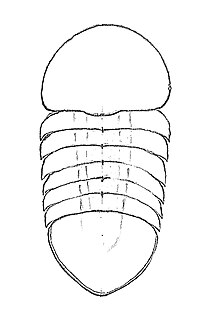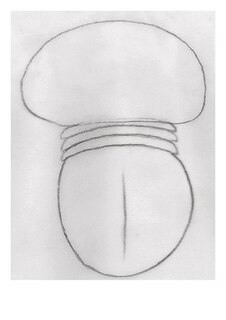
Opabinia regalis is an extinct, stem group arthropod found in the Middle Cambrian Burgess Shale Lagerstätte of British Columbia, Canada. It flourished from 505 million years ago to 487 million years ago during the Cambrian Period of the Paleozoic Era. It measured 2-3 inches in length and is presumed to have been a carnivore. Fewer than twenty good specimens have been described; 3 specimens of Opabinia are known from the Greater Phyllopod bed, where they constitute less than 0.1% of the community. Opabinia was a soft-bodied animal, averaging about 5.7 cm in length, and its segmented body had lobes along the sides and a fan-shaped tail. The head shows unusual features: five eyes, a mouth under the head and facing backwards, and a proboscis that probably passed food to the mouth. Opabinia probably lived on the seafloor, using the proboscis to seek out small, soft food.

Nektaspida is an extinct order of soft-bodied arthropods proposed by Raymond in 1920; its taxonomic status is uncertain. Specimens are known from the early Cambrian to the upper Silurian periods. A Russian find in the Vendian of the White Sea (=Ediacaran) has in 2006 also been attributed to this order, which would make it the earliest arthropod found yet. Whittington (1985) placed the order in the Trilobita. Cotton & Braddy (2000) place it in a new "Trilobite clade" containing the Trilobita, recognizing the close affinities of the nektaspids to trilobites. However this necessitates the inclusion of genera that look very little like trilobites., it was formerly placed in the stem-group to the chelicerata subdivision of the Arthropoda phylum. However, it currently considered part of Artiopoda.

Budd–Chiari syndrome is a very rare condition, affecting one in a million adults. The condition is caused by occlusion of the hepatic veins that drain the liver. It presents with the classical triad of abdominal pain, ascites, and liver enlargement. The formation of a blood clot within the hepatic veins can lead to Budd–Chiari syndrome. The syndrome can be fulminant, acute, chronic, or asymptomatic. Subacute presentation is the most common form.
Michael Hoenig is a German composer who has composed music for several films and games, in addition to two solo albums, including the highly acclaimed 1978 album Departure from the Northern Wasteland. In 1997, he was nominated for a Primetime Emmy Award for Outstanding Main Title Theme Music for composing the theme to the science fiction series Dark Skies.
Ammagnostidae is a family of trilobites in the suborder Agnostina, small, eyeless, isopygous trilobites with a thorax consisting of 2 segments only. Four genera have been assigned to it:
In biology, a phylum is a level of classification or taxonomic rank below kingdom and above class. Traditionally, in botany the term division has been used instead of phylum, although the International Code of Nomenclature for algae, fungi, and plants accepts the terms as equivalent. Depending on definitions, the animal kingdom Animalia or Metazoa contains approximately 31 phyla; the plant kingdom Plantae contains about 14, and the fungus kingdom Fungi contains about 8 phyla. Current research in phylogenetics is uncovering the relationships between phyla, which are contained in larger clades, like Ecdysozoa and Embryophyta.

Class Xenusia, the Xenusiids, represents the subset of lobopodian worms that fall in the stem-lineage of Onychophora. Their type genus is Xenusion. They have relatively large, annulated, cylindrical bodies. Their lobopod legs have tubercles at their bases. Some have large frontal appendages, although these may represent taphonomic artefacts. Their mouth is terminal or subterminal, and they are marine. They probably represent a grade rather than a clade.
Liwia is a genus of nektaspid, a soft-bodied stem-group chelicerate. It includes the following species, both are known from borehole samples several kilometers in depth from the Zawiszyn Formation in Poland, which has also yielded Peytoia infercambriensis.
Prioniodontida, also known as the "complex conodonts", is a large clade of conodonts that includes two major evolutionary grades; the Prioniodinina and the Ozarkodinina. It includes many of the more famous conodonts, such as the giant ordovician Promissum (Prioniodinina) from the Soom Shale and the Carboniferous specimens from the Granton Shrimp bed (Ozarkodinina). They are euconodonts, in that their elements are composed of two layers; the crown and the basal body, and are assumed to be a clade.

Buenaspis is a genus of small marine arthropods in the family Liwiidae, that lived during the early Cambrian period. Fossil remains of Buenaspis were collected from the Lower Cambrian Sirius Passet Lagerstätte of North Greenland. Buenaspis looks like a soft eyeless trilobite. It has a headshield slightly larger than the tailshield (pygidium), and in between them six thoracic body segments (somites). The genus is monotypic, its sole species being Buenaspis forteyi.

Soomaspis is a genus of small to average size marine arthropods in the Liwiidae Family, that lived during the late Ordovician. Fossil remains of Soomaspis were collected from the Soom Shale Lagerstätte in Western Cape, South Africa. Soomaspis looks like a large, soft agnostid trilobite. It has a headshield wider than the tailshield (pygidium), and in between them three thoracic body segments (somites). The genus is monotypic, its sole species being Soomaspis splendida.
Carolinites is a genus of trilobite, assigned to the Telephinidae family, that occurs during the Lower and Middle Ordovician. Carolinites had a pantropical distribution, and there is evidence that it lived in upper parts of the water column. The free cheeks of Carolinites are largely covered by its huge eyes, except for the attachment of large genal spines that extend downward, backward and lateral and gradually curving further backward. The glabella is slightly bulbous, the occipital ring is well defined, but further transglabellar furrows are lacking. The thorax has 10 segments. The axis of the pygidium is highly vaulted, with a curved spine emerging almost perpendicular to the midline and ending parallel to it and a node on each of the other three segments. Carolinites is known from what are today Australia (Tasmania), Canada (Alberta), China, France, Spitsbergen, and the United States (Utah).

Raphiophoridae is a family of small to average-sized trilobites that first occurred at the start of the Ordovician and became extinct at the end of the Middle Silurian.
The Long Island PGA Championship is a professional golf tournament played on Long Island, New York. It is sponsored by the Metropolitan section of the PGA of America. The current title of the event is the MasterCard Long Island PGA Championship. It was first held in 1935. Al Brosch won a record nine titles between 1939 and 1960. In addition to the record-setting success of Brosch, the Long Island PGA Championship has been won by many touring pros, including Jim Albus, Wiffy Cox, Jay Hebert, Tom Nieporte, Bruce Zabriski and others.
The Raymond C. Moore Medal for Paleontology is awarded by the Society for Sedimentary Geology to persons who have made significant contributions in the field which have promoted the science of stratigraphy by research in paleontology and evolution and the use of fossils for interpretations of paleoecology. The award is named after Professor Raymond C. Moore, the American paleontogist who helped to found the society.
Leona Valerie Theron is a judge on the Constitutional Court of South Africa and formerly of the Supreme Court of Appeal. She was first appointed to the bench in 1999, aged 33, becoming the first black woman judge on the KwaZulu-Natal High Court. She was appointed to the Constitutional Court on 1 July 2017 by President Jacob Zuma to replace recently retired Johann van der Westhuizen. Theron is married to Charles Sarjoo and has four children.
Trierarchuncus is a monotypic genus of alvarezsaurid theropod which includes a single species, Trierarchuncus prairiensis, which is known from fossils found in deposits of the Hell Creek Formation in Montana. It is the youngest known alvarezsaurid and one of the last non-avian dinosaurs, going extinct during the Cretaceous–Paleogene extinction event, which occurred approximately 66 million years ago.







